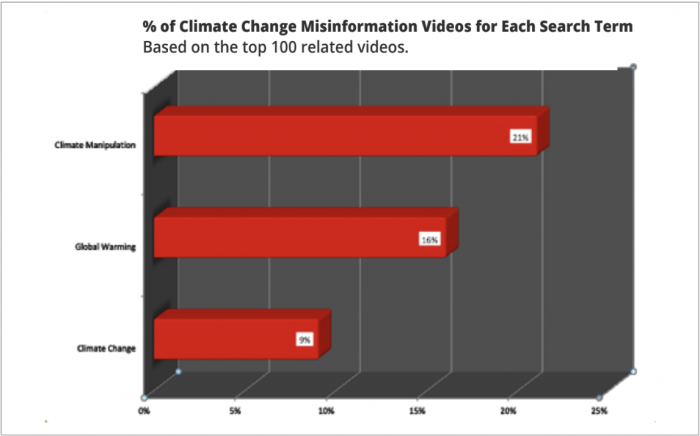
When an ad runs on a YouTube video, the video creator generally keeps 55 percent of the ad revenue, with YouTube getting the other 45 percent. This system’s designed to compensate content creators for their work.
But when those videos contain false information — say, about climate change — it’s essentially encouraging the creation of more misinformation content. Meanwhile, the brands advertising on YouTube often have no idea where their ads are running.
In a new report published today, the social-activism nonprofit Avaaz calculates the degree to which YouTube recommends videos with false information about climate change. After collecting more than 5,000 videos, Avaaz found that 16 percent of the top 100 related videos surfaced by the search term “global warming” contained misinformation. Results were a little better on searches for “climate change” (9 percent) and worse for the more explicitly misinfo-seeking “climate manipulation” (21 percent).
Those videos with misinformation had more views and more likes than other videos returned for the same search terms — by an average of 20 and 90 percent, depending on the search.
Avaaz identified 108 different brands running ads on the videos with climate misinformation; ironically enough, about one in five of those ads was from “a green or ethical brand” like Greenpeace or World Wildlife Fund. Many of those and other brands told Avaaz that they were unaware that their ads were running on climate misinformation videos.

The report doesn’t estimate the dollar figures involved in ads on these videos containing misinformation. But if you assume a CPM of $8.00 (YouTube’s median as of Q2 2019) and all videos are monetized, the 21.1 million views Avaaz calculated they’d received would have generated something like $75,000 for YouTube and $92,000 for the videos’ makers. That’s not nothing, especially when it comes to incentivizing more misinformation videos. But it’s also far from significant for YouTube or Google.
Avaaz cites YouTube’s much-debated algorithms as the main culprit, given that its video recommendations account for 70 percent of what people watch on the platform. “For every climate misinformation video someone watches or likes, similar content is likely to show up in that person’s recommendations, thereby trapping the viewer in an online bubble of misinformation,” the report says.
It was a year ago that YouTube said it would change its algorithms to recommend fewer conspiracy theory or misinformation videos, and anecdotal evidence has suggested at least some improvement. But these results, gathered in August 2019, suggest there’s still a ways to go.
What’s particularly concerning is that YouTube is one of the most used platforms among teenagers ages 13 to 17, and as we’ve written about before, young people aren’t great at detecting misinformation. One study by Stanford last year found that “96 percent of students didn’t think about how a relationship between a climate change website and a fossil fuel company could impact the website’s credibility.”YouTube has tried to reduce climate misinformation in the past by adding information boxes under its videos, but Avaaz notes that those boxes, when they do appear, often link to Wikipedia articles about general terms related to climate change and don’t indicate that the videos contain misinformation.
Judd Legum, who writes the newsletter Popular Information, spoke to Google (YouTube’s parent company) about the report’s findings:
In a statement to Popular Information, Google said its “recommendations systems are not designed to filter or demote videos or channels based on specific perspectives.” The company added that it has “significantly invested in reducing recommendations of borderline content and harmful misinformation, and raising up authoritative voices on YouTube.”
Google said that some climate misinformation videos are considered “harmful misinformation,” but some of the videos flagged by Avaaz are not. For example, Google told Popular Information it considers climate misinformation that is clipped from Fox News to be part of a legitimate public discourse on a political and scientific issue.
Avaaz’s four recommendations for YouTube include:
Read the full report here.